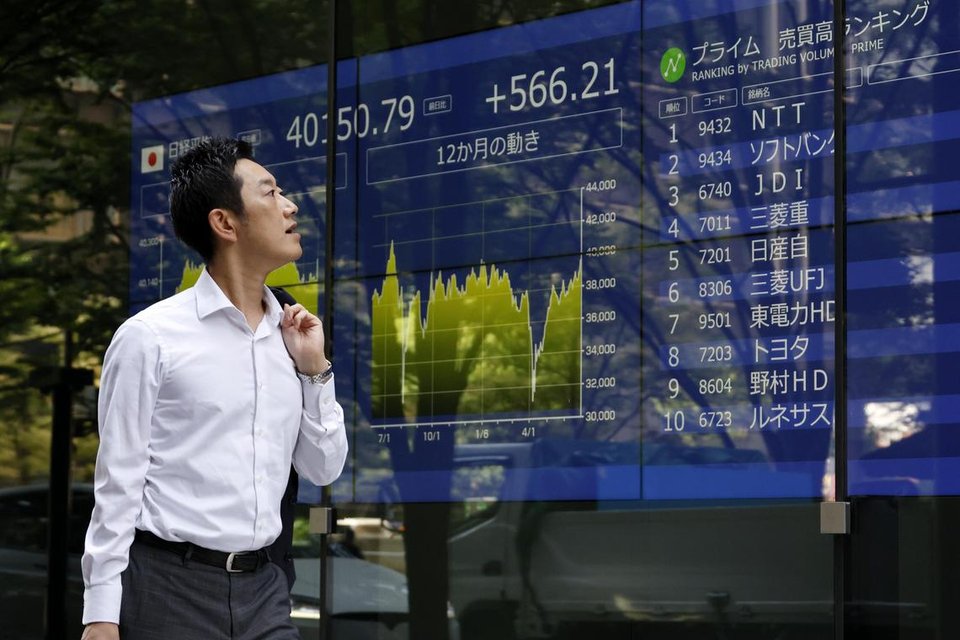Asia markets edge up as Trump signals still open to tariff talks

(Photo credit: EPA)
Source: The Straits Times
Asian shares edged higher on July 8 after US President Donald Trump suggested that he was still open to additional negotiations after imposing new tariff rates on partners including Japan and South Korea.
After announcing higher levies on several countries, Mr Trump said he was still open to additional negotiations and pushed off increased duties until at least Aug 1. The President also teased the possibility of additional delays, saying the notifications were “not 100 per cent firm”.
“This is carrot and stick play – stretch the deadline, tighten the grip, and remain focusing on a deal to be made,” said Ms Hebe Chen, a market analyst at Vantage Markets in Melbourne. “Despite the theatrics, it’s not far from market expectations, and a deal within two weeks still looks likely on the table.”
While Singapore’s Straits Times Index and China’s Shanghai Composite were unchanged at 9.35am, Japan’s Nikkei index rose 0.3 per cent, while Hong Kong’s Hang Seng Index and Australia’s S&P/ASX 200 inched up 0.1 per cent.
South Korea’s Kospi index jumped 1.5 per cent after the government said it will fix rules and regulations to address US demand to lower non-tariff barriers.
“We see this letter as a de facto extension of the grace period for imposing reciprocal tariffs until Aug 1,” South Korea’s Industry Ministry said on July 8, vowing to accelerate negotiations to reach a mutually beneficial agreement.
Japanese Prime Minister Shigeru Ishiba said on July 8 that Japan would continue negotiations with the United States to seek a bilateral trade deal that benefits both countries.
Mr Trump released the first in a series of tariff warning letters, just two days before agreements are due on countries facing his April 2 so-called reciprocal levies. The new rates include 25 per cent duties on goods from Japan, South Korea and Malaysia; 32 per cent on Indonesia; 35 per cent on Bangladesh; 36 per cent on Thailand and Cambodia; and 40 per cent on Laos and Myanmar.
Singapore, which was hit with a 10 per cent baseline tariff in April, has not yet heard from the US. White House press secretary Karoline Leavitt said on July 7 that additional letters will be sent in the coming days.
Despite the market turmoil from Mr Trump’s tariffs, stocks globally have rebounded from their April lows, reflecting optimism that Japan and other countries will strike deals with the US to avoid derailing growth.
So far, the US economy has held up under the threat of a spiralling global trade war. Hiring is healthy and inflation has remained tame. The Federal Reserve is wary about tariffs and wants to see how they feed through to output in the next few months.
A gauge of the US dollar retreated slightly on July 8. The greenback had jumped the most in three weeks on July 7 in a sign investors are confident the US economy can largely withstand the impact of trade disputes.
The latest tariff headlines are “a perfect storm for a recovery in the dollar especially as data continues to keep the Fed on the sidelines”, according to Mr Aroop Chatterjee, a strategist at Wells Fargo in New York.
“Investors should be alert to headline risk,” said Mr Fawad Razaqzada at City Index and Forex.com. “The scope for last-minute deals is high, but so too is the possibility of renewed trade tensions.”
One positive to be taken away from the latest trade developments was that the higher tariffs will not be in place during July. That means “an indirect extension” of the original 90-day pause that would expire on July 9, said Mr Ian Lyngen and Mr Vail Hartman at BMO Capital Markets.
“The outcome could certainly have been more dire for the economic outlook had the additional window of relief not been included in the latest trade-war salvo,” they noted.
The European Union is not expecting to receive a letter setting tariff rates imminently, according to a person familiar with those discussions. The EU is seeking to conclude a preliminary deal this week that would allow it to lock in a 10 per cent tariff rate beyond an Aug 1 deadline as they negotiate a permanent agreement.
Meantime, US Treasury Secretary Scott Bessent told CNBC said he expected to meet with his Chinese counterpart in the coming weeks.
Indian officials familiar with the matter said the nation had made its best offer on trade and the fate of an interim deal now lies in the hands of Mr Trump. Negotiators conveyed to Washington the red lines they were unwilling to breach in finalising an agreement, including allowing the US to export genetically modified crops to India, and opening up India’s dairy and automobile sectors to America.
In Rio de Janeiro, several leaders responded to Mr Trump’s tariff threats against the 10-member Brics group. Brazilian President Luiz Inacio Lula da Silva joined South Africa in blasting the US President.
In 2024, the list of Brics members expanded beyond the original group of Brazil, Russia, India, China and South Africa to include Egypt, Ethiopia, Indonesia, Iran, Saudi Arabia and the United Arab Emirates.
The countries in the bloc – which was designed to boost the nations’ international standing and challenge the US and Western Europe – account for more than half of the world’s population.
